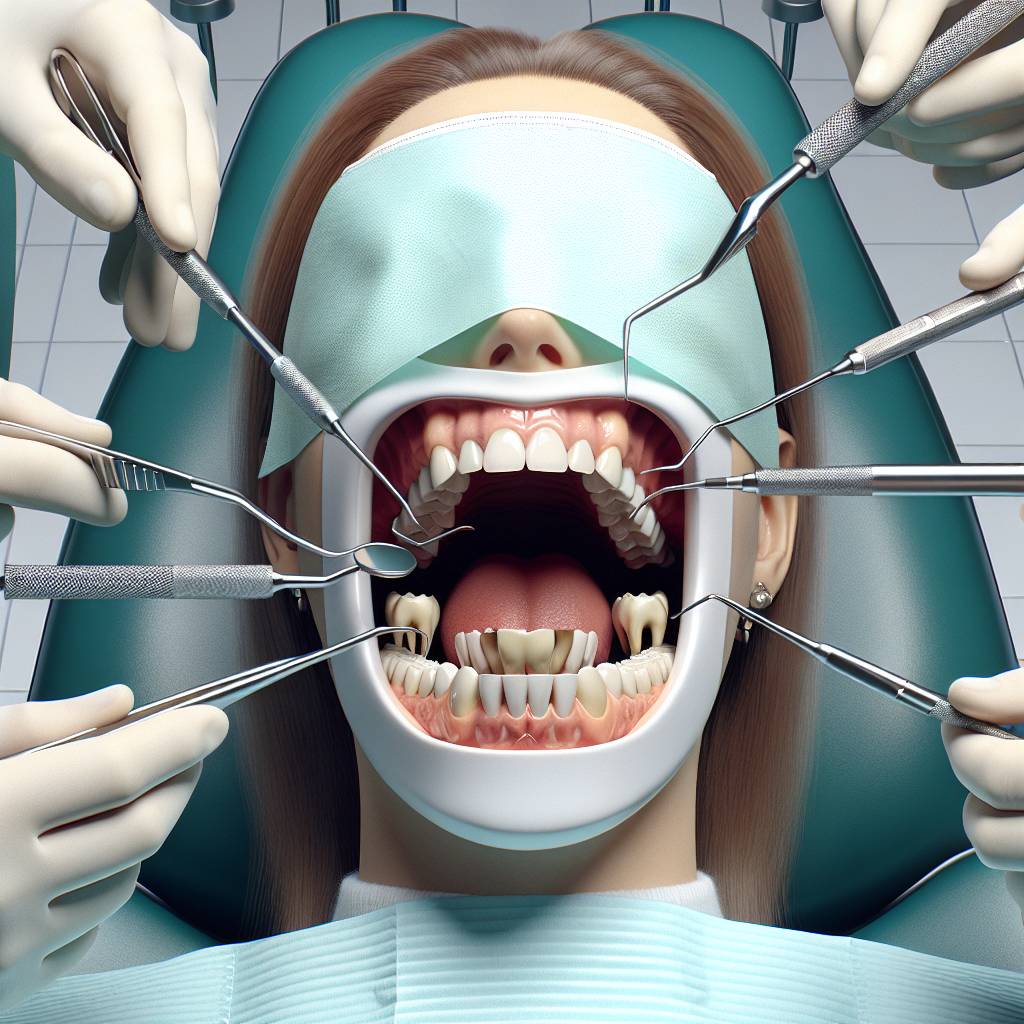Pulling teeth can be an uncomfortable experience, and it is often necessary when a tooth is too damaged to be saved. When a person needs to have multiple teeth pulled, it can be a daunting prospect. It is important to understand the limitations of the procedure in order to ensure that it is done safely and successfully. In this article, we will discuss how many teeth can be pulled at once and the potential risks involved.The number of teeth that can be pulled at one time depends on the condition of the teeth, the complexity of the extraction, and the overall health of the patient. Generally speaking, it is best to limit extractions to a maximum of four teeth per visit.
Benefits of Extracting Multiple Teeth at Once
Extracting multiple teeth at once can provide several benefits. One of the most obvious is the time saved by not having to go through multiple procedures. Instead of scheduling separate appointments for each tooth, the entire process can be completed in one visit. Additionally, it can be less expensive to extract multiple teeth compared to individual tooth extractions. This is due to the fact that many dental offices will charge a flat fee for multiple extractions instead of per tooth. Another benefit is that it allows for a more comprehensive treatment plan as multiple concerns can be addressed in one visit.
Another important benefit is reduced trauma to the mouth and gums. When teeth are extracted individually, there is more risk of causing damage to surrounding tissue and bone structures. Having all teeth extracted at once ensures that tissue damage is minimized, which can help reduce healing time and decrease patient discomfort post-procedure.
Finally, extracting all affected teeth at once eliminates the need for multiple recovery periods and ensures a consistent outcome across all treated areas. This means that there will be no inconsistencies in terms of healing or alignment of remaining teeth after treatment has been completed.
Overall, extracting multiple teeth at once provides several advantages including a cost-effective solution, reduced trauma to the mouth and gums, and a consistent outcome across all affected areas. Therefore, discussing this option with your dentist may be beneficial if you are needing more than one tooth extracted.
Possible Risks of Removing Multiple Teeth
The removal of multiple teeth at once can cause a number of potential risks. The most common risks associated with the extraction of multiple teeth include: increased bleeding, infection, pain, swelling, dry socket, nerve damage, and facial asymmetry.
Bleeding can be expected to occur during and after the procedure. If the bleeding is uncontrolled or prolonged it could require additional medical attention. Infection is another possible risk associated with tooth extraction. It is important to follow all post-operative instructions from your dentist to reduce the risk of infection.
Pain is to be expected after a multiple tooth extraction procedure. In some cases, pain may continue for several days after the procedure and may require pain medication prescribed by your dentist or doctor. Swelling can also occur around the extraction site and in some cases may continue for several days after the procedure. Applying cold compresses may help reduce swelling.
Dry socket is another possible risk associated with multiple tooth extractions which occurs when a blood clot fails to form in the socket where a tooth was extracted or if it does form but then gets dislodged or dissolves too early. This can be very painful and lead to infection if not dealt with properly by a dentist.
Nerve damage is also possible following multiple tooth extractions, especially if they are close to major nerves in the jawbone area such as roots near the mental nerve in lower jaw extractions or roots near the maxillary nerve in upper jaw extractions. Nerve damage can lead to numbness or tingling in parts of the face around the mouth area and chin region, as well as difficulties speaking and chewing food due to muscle weakness on one side of the face caused by paralysis of facial muscles on that side due to nerve damage.
Finally, facial asymmetry is another potential risk resulting from multiple tooth extractions that occurs when too many teeth are removed from one side of your mouth causing your mouth and face to become unbalanced or asymmetrical looking due to bone loss that happens over time without enough teeth remaining on one side for support and balance against its opposite side.
It is important for patients considering having multiple teeth extracted at once to discuss all potential risks with their dentist beforehand so they can make an informed decision about their oral health care needs.
Number of Teeth Extractable at One Time
The number of teeth that can be extracted at one time is affected by several factors. The most important factor is the location and size of the teeth. If a tooth is in an area that is difficult to access, such as the back molars, it may be difficult to remove more than one tooth at a time. Additionally, if the teeth are larger than normal, it may be difficult to remove multiple teeth at once. Other factors include the health of the surrounding bone and soft tissues, as well as the patient’s overall health and ability to tolerate surgery.
In some cases, two or more teeth can be removed simultaneously if they are in close proximity and easily accessible. However, if multiple teeth need to be removed due to overcrowding or other issues, it may be necessary to perform multiple extractions over multiple visits. This will ensure that each extraction is done safely and properly with minimal risk of complications.
Finally, it is important to note that some dentists may not recommend extracting more than one tooth at a time due to potential risks associated with more complex dental procedures. Therefore, it is important for patients to discuss their individual situation with their dentist before making any decisions about tooth extraction.
Pros of Having Multiple Teeth Removed in a Single Session
Removing multiple teeth in a single session can be a great time-saver for those who are busy with work or other commitments. Doing so in one appointment can save a person several trips to the dentist. It also reduces the amount of time spent waiting for an appointment to have each individual tooth extracted. Additionally, having multiple teeth removed at once may reduce overall costs associated with dental care, since more than one procedure is being done at once. Patients may also benefit from having more time to heal after the procedure, instead of having multiple sessions spread out over several weeks or months.
Cons of Having Multiple Teeth Removed in a Single Session
The most significant con of having multiple teeth removed in a single session is that it can lead to prolonged post-operative pain and discomfort. Since there will be more tissue damage, healing may take longer and result in more discomfort. Depending on the number and location of the teeth being removed, it may be difficult for the patient to eat or speak following the procedure. Additionally, removing multiple teeth at once may increase the risk of infection as more area has been disturbed than if each tooth had been extracted separately.

What Is the Procedure?
The procedure is a minimally invasive technique that uses radiofrequency energy to heat and shrink the lining of the nose. The procedure is performed under general anesthesia in an outpatient setting. During the procedure, a thin catheter is inserted into the nasal cavity and radiofrequency energy is applied to target tissues in order to reduce swelling and inflammation. The procedure usually takes about an hour and patients can return home the same day.
What Are the Benefits?
Radiofrequency ablation offers a number of benefits for those suffering from nasal congestion or sinusitis. It can reduce inflammation, improve air flow, decrease mucus production, and reduce pain associated with sinusitis. It also has a lower risk of side effects than other procedures such as surgery or steroid injections, and can be completed quickly with minimal downtime.
What Are the Risks?
As with any medical procedure, there are risks associated with radiofrequency ablation. These include infection, bleeding, damage to surrounding tissue, and pain or discomfort during or after the procedure. Additionally, there is a risk of recurrence of symptoms if not all of the affected tissues are treated during the procedure.
What Should I Expect During and After the Procedure?
Patients should expect some discomfort during the procedure as well as after it has been completed. This may include soreness in the area where the catheter was inserted, swelling or bruising at the site of insertion, and some drainage from your nose for up to 24 hours after treatment. Pain medications may be prescribed to help manage any discomfort associated with this procedure. Patients should also expect some degree of improvement in their symptoms within two weeks following treatment but full results may take up to six weeks or more depending on individual circumstances.
How Long Does It Take to Recover from Having Multiple Teeth Removed at Once?
Recovery time after having multiple teeth removed at once depends on a variety of factors, including the type of procedure that was performed, the number of teeth removed, and how quickly a person heals. Generally speaking, recovery can take anywhere from one to two weeks. During this time, it’s important to rest and take care of yourself so that you can heal properly.
Pain is usually the most intense in the first few days after multiple teeth are removed. Taking over-the-counter pain medications can help reduce discomfort during this time. Swelling is also common and can be managed by applying ice packs and keeping your head elevated while you sleep. You may experience some bleeding as well, which can be stopped by gently biting down on a gauze pad.
It’s important to follow all instructions given by your dentist after having multiple teeth removed. This will help ensure that you heal properly and minimize complications such as infection or excessive bleeding. Your dentist may also prescribe antibiotics to help prevent infection or provide special instructions for caring for your mouth while it heals.
During recovery it’s important to follow a soft food diet until you have fully healed. This includes avoiding hard foods such as popcorn kernels and raw vegetables. You should also avoid using straws or smoking, as these activities can dislodge the blood clots that form in the extraction sites, leading to excessive bleeding or dry socket.
If you experience any unusual symptoms such as severe pain, excessive bleeding, swelling, fever, or pus drainage after having multiple teeth removed at once, be sure to contact your dentist right away so they can evaluate you and provide treatment if needed. With proper care and rest, most people are able to make a full recovery within one to two weeks after having multiple teeth removed at once.
Aftercare for Patients Who Have Had Multiple Teeth Pulled At Once
After having multiple teeth pulled at once, it is important to take certain steps for proper aftercare. This includes avoiding vigorous activities such as running, lifting heavy objects, or straining the jaw during daily activities. It is also important to avoid forceful spitting and rinsing the mouth vigorously for the first 24 hours. It is recommended to keep the area clean with warm salt water rinses several times a day to help reduce swelling and pain associated with multiple tooth extractions. Additionally, it is important to not smoke or drink alcohol for at least 24 hours following the procedure.
It is essential to maintain a soft food diet for a few days following multiple tooth extractions in order to prevent further irritation of the area. It is also important to apply ice packs or cold compresses intermittently in order to reduce swelling and pain. Additionally, medications such as ibuprofen can be taken in order reduce pain and inflammation. If there are any signs of infection such as fever, redness, swelling, pain that worsens over time, or drainage from the site of extraction, it is important to consult a dentist immediately as this may indicate an infection that requires further treatment.
In order to ensure proper healing after having multiple teeth pulled at once, it is important to keep all follow-up appointments with one’s dentist and oral surgeon and report any unusual symptoms right away. Overall, following these simple steps can help ensure proper healing after tooth extractions so that one can experience minimal discomfort and heal quickly from their procedure.

Conclusion
It can be concluded that the number of teeth that can be pulled at once depends on the severity of the condition, the type of extraction, and the patient’s oral health. Generally, multiple teeth can be removed at once, but it is important to consult with a dentist to determine the safest and most effective course of action. In some cases, a single extraction may be recommended to limit trauma to the surrounding structures. Ultimately, it is important to assess each individual situation in order to ensure a safe and successful procedure.
The decision to pull multiple teeth at once should not be taken lightly. It is important for patients to discuss their options with their dentist in order to determine what would be best for their oral health and overall wellbeing. With proper preparation and informed consent, multiple teeth extractions can be a safe and successful procedure.

